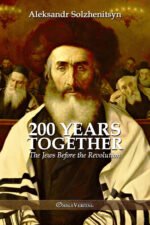-
200 anni insieme I
35,00 €
La storia del “problema ebraico” in Russia (e solo in Russia?) è soprattutto eccezionalmente ricca. Parlarne significa ascoltare nuove voci e trasmetterle al lettore. (In questo libro, le voci degli ebrei saranno ascoltate più spesso di quelle dei russi).Ma i vortici del clima sociale ci costringono sul filo del rasoio. È possibile sentire il peso di entrambe le parti, tutte le lamentele e le accuse, plausibili e improbabili, che crescono man mano.
Lo scopo che mi guida in questo lavoro sulla vita comune dei russi e degli ebrei consiste nel cercare tutti i punti necessari per una comprensione reciproca, tutte le possibili voci che, una volta liberate dall’amarezza del passato, possono condurci verso il futuro.
-
200 anni insieme II
35,00 €
Nel 1990, mentre terminavo Aprile 1917 e sistemavo l’enorme quantità di materiale non incluso ne La ruota rossa, decisi di presentare parte di quel materiale sotto forma di un saggio storico sugli ebrei nella rivoluzione russa.
Tuttavia, fu chiaro quasi subito che per comprendere quegli eventi il saggio doveva fare un passo indietro nel tempo. Così si è tornati indietro fino alla prima incorporazione degli ebrei nell’Impero russo, nel 1772. D’altra parte, la rivoluzione del 1917 ha dato un forte impulso all’ebraismo russo, quindi il saggio si è esteso naturalmente al periodo post-rivoluzionario. Così è nato il titolo Duecento anni insieme.
-
200 Years Together I
35,00 €
The history of the ‘Jewish Problem’ in Russia (and Russia only?) is above all else exceptionally rich. Talking about it means listening to new voices and passing them on to the reader. (In this book, the Jewish voices will be heard more often than those of the Russians.)
But the whirlwinds of the social climate force us towards the razor’s edge. You can feel the weight of both sides, all the grievances and accusations, plausible as well as improbably, which grow as they go.
-
200 Years Together II
35,00 €
In 1990, while finishing April 1917 and sorting out the enormous amount of material not included in The Red Wheel, I decided to present some of that material in the form of a historical essay about Jews in the Russian revolution.
Yet it became clear almost immediately that in order to understand those events the essay must step back in time. Thus, it stepped back to the very first incorporation of the Jews into the Russian Empire in 1772. On the other hand, the revolution of 1917 provided a powerful impetus to Russian Jewry, so the essay naturally stretched into the post-revolutionary period. Thus, the title Two Hundred Years Together was born.
-
Vladimir Putin & Eurasia
30,00 €
In the present work, which is a singularly dangerous book, not to be placed in all hands, I have done nothing more than to bear witness to the ongoing, consequent developments of a certain imperial revolutionary consciousness in Europe. Step by step. Thus accompanying its own course, and more often than not anticipating it: it was not a follow-up analytical work that I undertook to do there, but a fundamentally visionary work, whose own horizon was situated in the history of the beyond the end of history.




